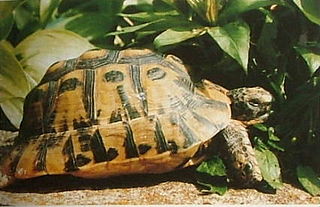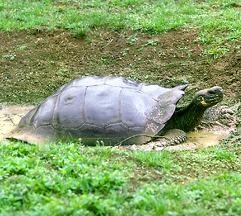
Tortoises are reptiles of the family Testudinidae of the order Testudines. Like other turtles, tortoises have a shell to protect from predation and other threats. The shell in tortoises is generally hard, and like other members of the suborder Cryptodira, they retract their necks and heads directly backward into the shell to protect them.

The Pinta Island tortoise, also known as the Pinta giant tortoise, Abingdon Island tortoise, or Abingdon Island giant tortoise, was a subspecies of Galápagos tortoise native to Ecuador's Pinta Island.

Johann, or Jean-Frederic, Hermann, or Herrmann, was a French physician and naturalist.

The marginated tortoise is a species of tortoise in the family Testudinidae. The species is endemic to Greece, Italy, and the Balkans in Southern Europe. It is the largest European tortoise. The marginated tortoise is herbivorous, and brumates for the winter.

The Greek tortoise, also known commonly as the spur-thighed tortoise, is a species of tortoise in the family Testudinidae. Testudo graeca is one of five species of Mediterranean tortoises. The other four species are Hermann's tortoise, the Egyptian tortoise, the marginated tortoise, and the Russian tortoise. The Greek tortoise is a very long-lived animal, achieving a lifespan upwards of 125 years, with some unverified reports up to 200 years.

Hermann's tortoise is a species of tortoise. Two subspecies are known: the western Hermann's tortoise and the eastern Hermann's tortoise. Sometimes mentioned as a subspecies, T. h. peleponnesica is not yet confirmed to be genetically different from T. h. boettgeri.

The Aldabra giant tortoise is a species of tortoise in the family Testudinidae. The species is endemic to the islands of the Aldabra Atoll in the Seychelles. It is one of the largest tortoises in the world. Historically, giant tortoises were found on many of the western Indian Ocean islands, as well as Madagascar, and the fossil record indicates giant tortoises once occurred on every continent and many islands with the exception of Australia and Antarctica. Many of the Indian Ocean species were thought to be driven to extinction by over-exploitation by European sailors, and they were all seemingly extinct by 1840 with the exception of the Aldabran giant tortoise on the island atoll of Aldabra. Although some remnant individuals of A. g. hololissa and A. g. arnoldi may remain in captivity, in recent times, these have all been reduced as subspecies of A. gigantea.

The Russian tortoise, also commonly known as the Afghan tortoise, the Central Asian tortoise, Horsfield's tortoise, four-clawed tortoise, and the (Russian) steppe tortoise, is a threatened species of tortoise in the family Testudinidae. The species is endemic to Central Asia. Human activities in its native habitat contribute to its threatened status.

The leopard tortoise is a large and attractively marked tortoise found in the savannas of eastern and southern Africa, from Sudan to the southern Cape. It is the only extant member of the genus Stigmochelys, although in the past, it was commonly placed in Geochelone. This tortoise is a grazing species that favors semiarid, thorny to grassland habitats. In both very hot and very cold weather, it may dwell in abandoned fox, jackal, or aardvark holes. The leopard tortoise does not dig other than to make nests in which to lay eggs. Given its propensity for grassland habitats, it grazes extensively upon mixed grasses. It also favors succulents and thistles.

The European pond turtle, also called commonly the European pond terrapin and the European pond tortoise, is a species of long-living freshwater turtle in the family Emydidae. The species is endemic to the Western Palearctic.

Testudo, the Mediterranean tortoises, are a genus of tortoises found in North Africa, Western Asia, and Europe. Several species are under threat in the wild, mainly from habitat destruction.

The Tunisian tortoise or Nabeul tortoise is a subspecies of Greek tortoises. It was originally described as a new species in 1990, and even placed in a distinct genus. The spur-thighed or "Greek" tortoises are usually collectively referred to as Testudo graeca, but this covers a wide variety of subspecies that have very different ecological and morphological characteristics and appear to comprise at least three phylogenetic lineages. As its name implies, it is found in Tunisia and nearby Algeria.

The Galápagos tortoise or Galápagos giant tortoise is a species of very large tortoise in the genus Chelonoidis. It comprises 15 subspecies. It is the largest living species of tortoise, with some modern Galápagos tortoises weighing up to 417 kg (919 lb). With lifespans in the wild of over 100 years, it is one of the longest-lived vertebrates. Captive Galapagos tortoises can live up to 177 years. For example, a captive individual, Harriet, lived for at least 175 years. Spanish explorers, who discovered the islands in the 16th century, named them after the Spanish galápago, meaning "tortoise".

Kleinmann's tortoise, also called commonly the Egyptian tortoise, Leith's tortoise, and the Negev tortoise, is a critically endangered species of neck-hiding tortoise in the family Testudinidae. The species is native to Egypt, Libya, and Israel. The species was once more widespread, but its numbers are now dwindling. The species is nearly extinct in Egypt, and complete extinction in the wild is a looming threat unless more actions are taken to protect this species.

The Volcán Wolf giant tortoise, also known commonly as the Wolf Volcano giant tortoise and the Cape Berkeley giant tortoise, is a subspecies of Galápagos tortoise in the family Testudinidae. The subspecies is native to the north side of Ecuador's Isabela Island. Chelonoidis becki has links to two different lineages including that of Chelonoidis darwini from the nearby island of Santiago. C. becki has been found to be the product of a double colonization event beginning around 199,000 years ago, and had been formed through introgression, where greater male selectivity was exhibited by purebred females in one of the lineages. It is most commonly found on the northern, western, and southwestern slopes of Volcán Wolf, the volcano that it is named for. Having evolved to live in a specific environment, C. becki only occupies an estimated range of about 263 square kilometers. An estimated 1,150 Volcán Wolf giant tortoises inhabit Volcán Wolf.
Chelonobacter is a genus of bacteria from the family of Pasteurellaceae with one known species. Chelonobacter oris is associated with diseases of the respiratory tract of Hermann's tortoise.

The Santiago Island giant tortoise, also known commonly as the Santiago giant tortoise and the James Island tortoise, is a subspecies of Galápagos tortoise in the family Testudinidae. The subspecies is endemic to Santiago Island in the Galápagos.

Solitudo is an extinct genus of tortoise that was found during the Pliocene and Pleistocene on the Mediterranean islands of Menorca, Malta and Sicily. The genus includes three described species, Solitudo robusta, Solitudo gymnesica and Solitudo sicula as well as a likely fourth, undescribed species from Monte Pellegrino in Sicily. Solitudo sicula, the youngest of the species, died out approximately 12.5 thousand years BP. The largest species, Solitudo gymnesica, has been estimated to have reached a carapace length of 1.1–1.3 m (3.6–4.3 ft).

















